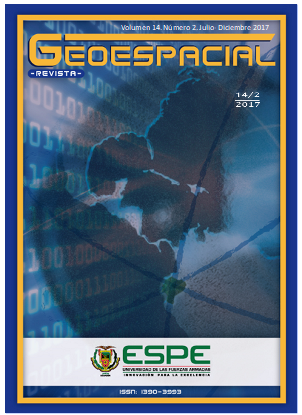TIPOLOGÍA Y CINÉTICA DEL DESLIZAMIENTO REINA DEL CISNE (CUENCA) A PARTIR DE FOTOGRAFÍAS AÉREAS, GPS, ESCÁNER LÁSER TERRESTRE Y ENSAYOS GEOTÉCNICOS DEL SUELO.
Contenido principal del artículo
Resumen
En marzo de 2017 se desencadenó el deslizamiento de la ladera ubicada en el sector Reina del Cisne (Cuenca) a raíz del corte que se le aplicó a la ladera para la construcción de una pequeña vía de acceso a una casa. El deslizamiento está condicionado por la litología de la ladera (arenas principalmente) y su elevada pendiente (hasta 40 º). Desde marzo hasta de junio de 2017, período analizado en este trabajo, el deslizamiento ha provocado daños estructurales parciales o totales en viviendas, daños en un campo de cultivo y el taponamiento total de la vía que lo desencadenó. Las visitas de campo desde el mes de marzo’17 y la comparación con CloudCompare de las nubes de puntos obtenidas con escáner láser terrestre en los meses de mayo y junio de 2017, han puesto de manifiesto la alta actividad de este deslizamiento. Se ha analizado tridimensionalmente una vivienda afectada y ésta ha experimentado hundimiento y basculamiento hacia ladera abajo con desplazamientos puntuales de hasta 91 cm en 20 días.
Detalles del artículo
Sección
Artículos Técnicos
Acceso a archivos
Los artículos publicados en la Revista Geoespacial se sujetan a las directrices de OPEN ACCES, en cuanto a la apertura de su contenido hacia todos los visitantes del sitio.
Derechos que conserva el autor:
El autor conserva los derechos morales de publicación
Cesión de derechos a autores:
Se cede los derechos de citas, referencias y temas relacionados con aspectos académicos y de investigación
Cómo citar
TIPOLOGÍA Y CINÉTICA DEL DESLIZAMIENTO REINA DEL CISNE (CUENCA) A PARTIR DE FOTOGRAFÍAS AÉREAS, GPS, ESCÁNER LÁSER TERRESTRE Y ENSAYOS GEOTÉCNICOS DEL SUELO. (2020). Revista Geoespacial, 14(2), 50-66. https://journal.espe.edu.ec/ojs/index.php/revista-geoespacial/article/view/1599

